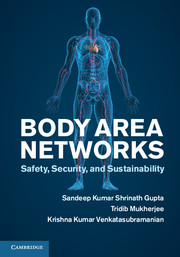Book contents
6 - Sustainability
Published online by Cambridge University Press: 05 April 2013
Summary
Environmental sustainability has been of increasing interest in designing any system in recent times. Computing systems usually contribute to this drive of sustainability from two different perspectives: (i) the energy perspective and (ii) the equipment-recycling perspective. Sections 6.1 and 6.2 describe these perspectives of sustainability of computing systems in general. All subsequent sections will focus on how to ensure sustainability for BANs from the energy perspective.
The energy perspective
Sustainability from the energy perspective, also referred to as energy-sustainability, has two main objectives: (i) reducing the carbon footprint from the power grid and (ii) reducing the need for battery replacement (for computing equipment running on limited-energy batteries). To ensure that both these objectives are attained, energy-sustainability can be described as the balance between the power required for computation and the power available from renewable or green energy sources (e.g., sources in the environment such as solar power). Ideally, if the power available from external renewable energy sources is more than the power required for computation then a power grid (or battery) might not be needed, and computation can be said to be energy-sustainable. However, in reality, both the available and the required power may vary over time. For example, solar power is available only during the day, but power may be required during the night (depending on the time-varying computing operations performed). In such a case, power may need to be extracted from a power grid (or battery) during the night, thus making computing operations unsustainable.
- Type
- Chapter
- Information
- Body Area NetworksSafety, Security, and Sustainability, pp. 84 - 103Publisher: Cambridge University PressPrint publication year: 2013



